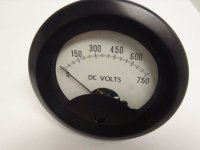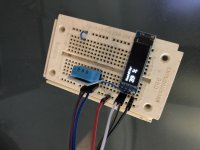Hi,
For my current project I’m looking for a digital panel display that can display DC voltages up to (and slightly above) 600V. This meter has to be placed inside the amplifier control unit.
I know many people use the standard 200mV display modules, with voltage dividing resistors in front.
I want to see 600.0 instead of 0600.0 displayed. I want to measure many more voltages (like 400 V, -120V, -50V, 12V, 15V, -15V and 6.3V (DC, not AC), so I do need one decimal. It would be nice if the meter dan display the V symbol too.
So far I haven’t found the right meter for this. Any suggestions are welcome.
What do you use?
Regards, Gerrit
P.S. I intend to use a similar display for current measurements, by converting the voltage over the cathode resistor to mA readings.
For my current project I’m looking for a digital panel display that can display DC voltages up to (and slightly above) 600V. This meter has to be placed inside the amplifier control unit.
I know many people use the standard 200mV display modules, with voltage dividing resistors in front.
I want to see 600.0 instead of 0600.0 displayed. I want to measure many more voltages (like 400 V, -120V, -50V, 12V, 15V, -15V and 6.3V (DC, not AC), so I do need one decimal. It would be nice if the meter dan display the V symbol too.
So far I haven’t found the right meter for this. Any suggestions are welcome.
What do you use?
Regards, Gerrit
P.S. I intend to use a similar display for current measurements, by converting the voltage over the cathode resistor to mA readings.
You should be able to to change decimal points with those digital panel meters. The quick and dirty method would be to buy some really cheap digital multimeters and use the insides. Just be mindful of how they're powered.
You could always use a little microprocessor and customize the display any way you'd like.
You could always use a little microprocessor and customize the display any way you'd like.
Pick a microcontroller + a 16 * 2 LCD.
Gives you 6 - 8 input channels.
Display several or all simultaneously.
In any format you prefer
Gives you 6 - 8 input channels.
Display several or all simultaneously.
In any format you prefer
There's a way to set the decimal point, I believe with a solder bridge on a pad.
But if you want the decimal to change position with the reading, you'll need an
autoranging DVM. There are plenty of low cost ones. Why do it the hard way?
These cheap panel meters must be mounted on an insulating panel, with a clear
piece of plexi in front so no one can touch it, since the HV isolation is not specified.
But if you want the decimal to change position with the reading, you'll need an
autoranging DVM. There are plenty of low cost ones. Why do it the hard way?
These cheap panel meters must be mounted on an insulating panel, with a clear
piece of plexi in front so no one can touch it, since the HV isolation is not specified.
Last edited:
I know it could be done with a microcontroller and a display, but I have no idea how to make this. I think this is a no go area for me, unless there is something readymade available. I haven’t found any so far.
I definitely don’t want to use a DVM, but real panel mount meters. One for voltages, one for currents. Both represented by a voltage.
I’m sure there will be options to get this done, but I haven’t found the right meter yet.
Regards, Gerrit
I definitely don’t want to use a DVM, but real panel mount meters. One for voltages, one for currents. Both represented by a voltage.
I’m sure there will be options to get this done, but I haven’t found the right meter yet.
Regards, Gerrit
I've just been looking at metering for a simple valve tester I'm building, it's trickier than it looks.First off,how accurate must it be? The cheap Chinese panel meters on Ebay etc aren't accurate in my experience.
Second if your wanting to measure a range of voltages you'll need to employ some sort of switching be that digital or analogue type.
See datasheet for this meter attached. To enable it to read up to 200v you just switch in resistor dividers,it should be possible to do this for 600v too, just different resistor values in a 10:1 ratio. Meter available here - Voltcraft DVM-210 DC Digital Panel Meter | Rapid Online
Lastly, if you want a decent meter expect to have to pay more than £10. Proper meters cost money.
One last thing not mentioned is protection your £10 cheap Chinese meter won't have any, chucking 600v at it even with resistive dividers is potentially problematic.
Andy.
Second if your wanting to measure a range of voltages you'll need to employ some sort of switching be that digital or analogue type.
See datasheet for this meter attached. To enable it to read up to 200v you just switch in resistor dividers,it should be possible to do this for 600v too, just different resistor values in a 10:1 ratio. Meter available here - Voltcraft DVM-210 DC Digital Panel Meter | Rapid Online
Lastly, if you want a decent meter expect to have to pay more than £10. Proper meters cost money.
One last thing not mentioned is protection your £10 cheap Chinese meter won't have any, chucking 600v at it even with resistive dividers is potentially problematic.
Andy.
Attachments
Ive had no trouble with chinese meters, they use off the shelf chipsets after all. but if you start range switching their accuracy does suffer. I think for a valve tester this hardly matters as valve testers dont need this kind of accuracy. Have you looked at the Sussex design?
Another option is to roll your own with ICL7107 or equivalent. Then you can use high quality displays ect.
For measuring anode current you can try an isolation amplifier like HCPL7800 but you need added circuitry.
Another option is to roll your own with ICL7107 or equivalent. Then you can use high quality displays ect.
For measuring anode current you can try an isolation amplifier like HCPL7800 but you need added circuitry.
For ground referenced voltages, I don't see any protection problem - of course your dividers need to be rated for the necessary voltage - likely two series resistors for 600V. A 4 1/2 digit meter to display 600.0 won't be very accurate at 6.3. If two ranges are enough, decimal point can be switched on or off, (jumper it to the unused pin on the I/O connector). And of course meter switch needs to switch leads for negative voltages as this reads positive voltages only. Isolated supply of 9V, 20 mA is no big deal.
I guess you want digital but if not:
Yokogawa 84R2035 271-320smsm NS10239EK 0 - 750VDC Panel Meter L4 | eBay
Yokogawa 84R2035 271-320smsm NS10239EK 0 - 750VDC Panel Meter L4 | eBay
Attachments
Arduino boards are totally worth getting to know. I really don't enjoy programming but after 5 minutes of work here's an Arduino measuring the humidity from a sensor on a little oled display. Most boards have a bunch of analog inputs at 8 or 10 bits so just build a divider with a zener for protection and you have a 6 channel meter.
Attachments
I've been using these 3 wire units for breadboarding powered by 9V battery. They go up to 1000 volts. If you are wiring more than one meter into a circuit just note that if the meters have a common supply that you are not causing a short circuit somewhere, power each meter from its own supply if the multiple meters are not all using the same ground reference.
YB27 Three Wires LED Digital Voltage Meter Voltmeter DC 0 10V 30V 100V 300V 600V 1000V Voltmeter Volt Panel Meter Voltage Tester|Voltage Meters| - AliExpress
YB27 Three Wires LED Digital Voltage Meter Voltmeter DC 0 10V 30V 100V 300V 600V 1000V Voltmeter Volt Panel Meter Voltage Tester|Voltage Meters| - AliExpress
It could be argued that if your DC conditions are out because of poor metering your test results will be out to, though that in turn depends on whether your just after a "good/pass" type test or something more accurate.Yep, I've seen the Sussex, been following it from the start.I think for a valve tester this hardly matters as valve testers dont need this kind of accuracy. Have you looked at the Sussex design?
The meter I'm using for heater voltage is out by around 20mV but goes up as voltage goes up; it's a cheap £5 jobby 100v & 10A.
You get line powered units the size of DMM display, I will put a photo later.
And multi function meters are available, DC will have to check.
Look up Meco and Kusum Meco in India, and Rishabh.
And multi function meters are available, DC will have to check.
Look up Meco and Kusum Meco in India, and Rishabh.
It could be argued that if your DC conditions are out because of poor metering your test results will be out to, though that in turn depends on whether your just after a "good/pass" type test or something more accurate.Yep, I've seen the Sussex, been following it from the start.
The meter I'm using for heater voltage is out by around 20mV but goes up as voltage goes up; it's a cheap £5 jobby 100v & 10A.
Id be more concerned with wiring voltage drops depending on where you measure the filament voltage there can be quite a bit of drop on power tubes, especially if a switch matrix is involved.
My current idea is to build something like the sussex but with flyback power supplies for the HT G1 and buck for the filaments. so it can be ran without an expensive custom transformer. so far ive gotten the HT flyback working in a prototype.
In reality, if you get the ICL71XX based panel meters from china, and a decent 1:10000 devider from your never going to be out more than 0.5%. even if you range switch.
1776-C68 is what im planning on using for the grid1 divider, with 20 and 200V range.
Right now I’m looking at the Lascar DPM950 Panel Display, Compact, 3.5 Digit, LCD, 9 Vdc, 150 µA.
I think it may be suitable with the right divider resistors and some switching.
Regards, Gerrit
I think it may be suitable with the right divider resistors and some switching.
Regards, Gerrit
- Home
- Amplifiers
- Tubes / Valves
- Display needed for voltage measurements

